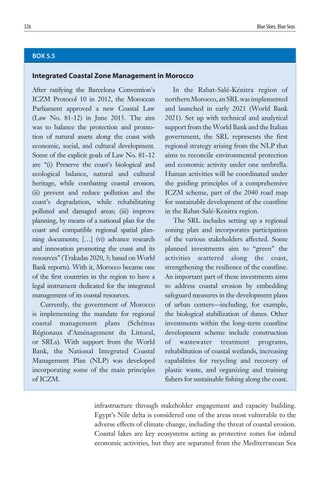326
Blue Skies, Blue Seas
BOX 5.5
Integrated Coastal Zone Management in Morocco After ratifying the Barcelona Convention’s ICZM Protocol 10 in 2012, the Moroccan Parliament approved a new Coastal Law (Law No. 81-12) in June 2015. The aim was to balance the protection and promotion of natural assets along the coast with economic, social, and cultural development. Some of the explicit goals of Law No. 81–12 are “(i) Preserve the coast’s biological and ecological balance, natural and cultural heritage, while combating coastal erosion; (ii) prevent and reduce pollution and the coast’s degradation, while rehabilitating polluted and damaged areas; (iii) improve planning, by means of a national plan for the coast and compatible regional spatial planning documents; […] (vi) advance research and innovation promoting the coast and its resources” (Trakadas 2020, 3; based on World Bank reports). With it, Morocco became one of the first countries in the region to have a legal instrument dedicated for the integrated management of its coastal resources. Currently, the government of Morocco is implementing the mandate for regional coastal management plans (Schémas Régionaux d’Aménagement du Littoral, or SRLs). With support from the World Bank, the National Integrated Coastal Management Plan (NLP) was developed incorporating some of the main principles of ICZM.
In the Rabat-Salé-Kénitra region of northern Morocco, an SRL was implemented and launched in early 2021 (World Bank 2021). Set up with technical and analytical support from the World Bank and the Italian government, the SRL represents the first regional strategy arising from the NLP that aims to reconcile environmental protection and economic activity under one umbrella. Human activities will be coordinated under the guiding principles of a comprehensive ICZM scheme, part of the 2040 road map for sustainable development of the coastline in the Rabat-Salé-Kenitra region. The SRL includes setting up a regional zoning plan and incorporates participation of the various stakeholders affected. Some planned investments aim to “green” the activities scattered along the coast, strengthening the resilience of the coastline. An important part of these investments aims to address coastal erosion by embedding safeguard measures in the development plans of urban centers—including, for example, the biological stabilization of dunes. Other investments within the long-term coastline development scheme include construction of wastewater treatment programs, rehabilitation of coastal wetlands, increasing capabilities for recycling and recovery of plastic waste, and organizing and training fishers for sustainable fishing along the coast.
infrastructure through stakeholder engagement and capacity building. Egypt’s Nile delta is considered one of the areas most vulnerable to the adverse effects of climate change, including the threat of coastal erosion. Coastal lakes are key ecosystems acting as protective zones for inland economic activities, but they are separated from the Mediterranean Sea






